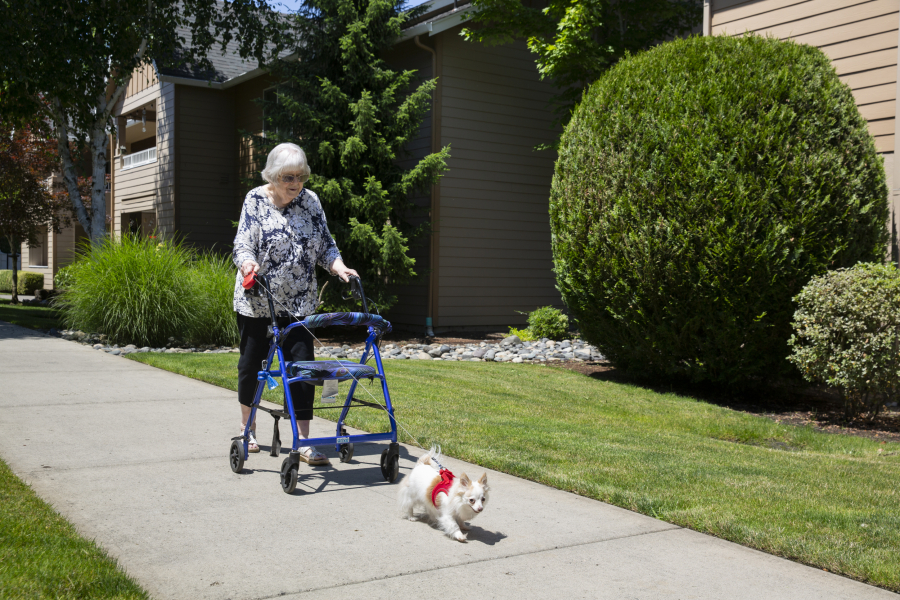In her early 30s, Sharon Pevey of Vancouver paid $225 monthly for a three-bedroom, two-bath duplex with a couple of fireplaces and full basement. Because her rent was so low, she was able to save and buy her first home with cash.
Forty years later, she pays $1,100 a month for her manufactured home to sit on dirt.
“Young people now will never have this chance to save for (a home) because prices for houses are so high, most are living on the edge,” said Pevey, 75.
Financial squeezes are felt across the housing spectrum: seniors on fixed incomes who can’t make rent; full-time workers living in their cars; single mothers trying to feed their children while also keeping a roof over their heads. From 2019 to 2022, rents rose almost 14 percent in Clark County, according to data compiled by the Washington Post.
The median rent for a one-bedroom apartment in the county is more than $1,600. With trends predicting rent will continue to rise, many renters and housing advocates say rent control or stabilization is the clear solution. Yet, rent control or rent-increase caps hold a long and polarizing history in Washington, with landlords arguing that it would have negative impacts on renters in the long term.
Earlier this year, housing advocates, landlords and lawmakers engaged in heated debates around legislation that would create more renter protections. The two most-talked-about proposals were House bills 1388 and 1389 — both aimed at limiting rent increases for tenants.
The bills didn’t pass.
“Last legislative hearing, many renters testified (to rent increases). … Landowners and builders stormed the legislative hearings, claiming that building was the only way (to solve the problem),” said Pevey. “But apartment living is not stable living. It only prolongs homelessness. My take on housing is to keep people in the homes they already have.”
Polarizing debate
Pevey clutched a stack of yellow-lined paper as she sat across from state senators.
Reading from the black ink etched into the pages, Pevey detailed how despite owning her manufactured home, she is still at the mercy of exorbitant rental costs due to leasing the land on which her unit sits.
“The manufactured-home communities are probably the last of the affordable homes now — although they’re not so affordable,” she said, detailing how most manufactured-home communities are made up of seniors.
After a sudden divorce, Pevey was thrust into a housing market in which she was not prepared to buy. Anything halfway affordable was tethered by price wars, she recalls. With three days until she needed to move out, Pevey bought a home in a 55-plus manufactured-home community.
Five years ago, she paid $525 for the land — “expensive but doable,” according to Pevey. Now she pays $1,100.
“We live in constant fear of the next rent increase,” Pevey said. Her rent will go up again in January.
Pevey’s story represents a much larger issue that renters across Clark County face.
Rent-stabilization proponents say it would offer renters more ability to predict their rent increases, according to Michele Thomas, director of advocacy for the Washington Low Income Housing Alliance.
A 2022 data set from the Council for the Homeless showed that homelessness in Clark County is on the rise. Rental rates were one of the drivers.
According to a study from Policylink, limiting rent hikes reduces the risk of homelessness. Rent caps would also increase housing security and affordability over the long term, the study argued.
“I think it’s important to not believe the mainstream talking points that always say that rent stabilization will lead to bad outcomes,” said Thomas. “Those talking points are created by the wealthy few, and it’s absolutely not true.”
Thomas said renters and advocates are gearing up to propose rent stabilization once again next legislative session.
On the other side of the coin, landlord groups like the Clark County Rental Association opposed rent control. Arguments during the legislative session included that rent control would help tenants only in the short run, but impact affordability in the long term.
Sue Denfeld, president of the association, said rent control would force small landlords, who are not able to raise rent to fair market value, to leave the rental market due to not making a profit.
“If we lose our smaller landlords, then those rental units go on the market, and they don’t always come back as rental sales. They’re usually purchased as a property, and that lowers the inventory for affordable housing,” Denfeld said.
Rebecca Diamond, a Stanford University professor and founder of the school’s Cities, Housing and Society Lab, concluded in a study that rent control has only short-term benefits.
“Rent control appears to help affordability in the short run for current tenants but in the long run decreases affordability, fuels gentrification and creates negative externalities on the surrounding neighborhood,” Diamond said. “If society desires to provide social insurance against rent increases, it may be less distortionary to offer this subsidy in the form of a government subsidy or tax credit.”
Borrowed ideas
Oregon established statewide rent control in 2019. As of January 2023, rent increases cannot exceed 14.6 percent. The Oregon law doesn’t have enough years under its belt to show long-term results, but other communities across the world illustrate the complexities of rent control.
In 2020, a rent-control law in Berlin was established to interrupt the swelling rates that had impacted renters for years. The law also halted all rent hikes for five years. But in 2021, a court deemed the law unconstitutional, saying the city did not have the right to make the law, so it was never valid.
Retracing steps, economists studied the impacts of the Berlin law on the housing market and found that the city saw a significant drop in rental listings, because tenants were not moving from their rent-capped apartments. Renters navigating the market then found it almost impossible to find a new home.
San Francisco’s supply of rental units declined by 15 percent from 1980 to 2016, when the city had rent-control policies. New York City has a small portion of its homes rent-capped. A 2019 study by the Columbia Business School said rent control in New York has reduced housing inequity for low-income families.
Rent-control advocates say that although bills did not pass this legislative session, they plan to resurrect them next year.
“When lawmakers stand up to protect renter households, our entire community benefits. … We can see more people entering into first-time homeownership. We can see our young adults doing much better, having a lot more stability,” said Thomas. “People won’t feel as financially pinched. The impacts are enormous when everybody has a safe and healthy place to call home.”





